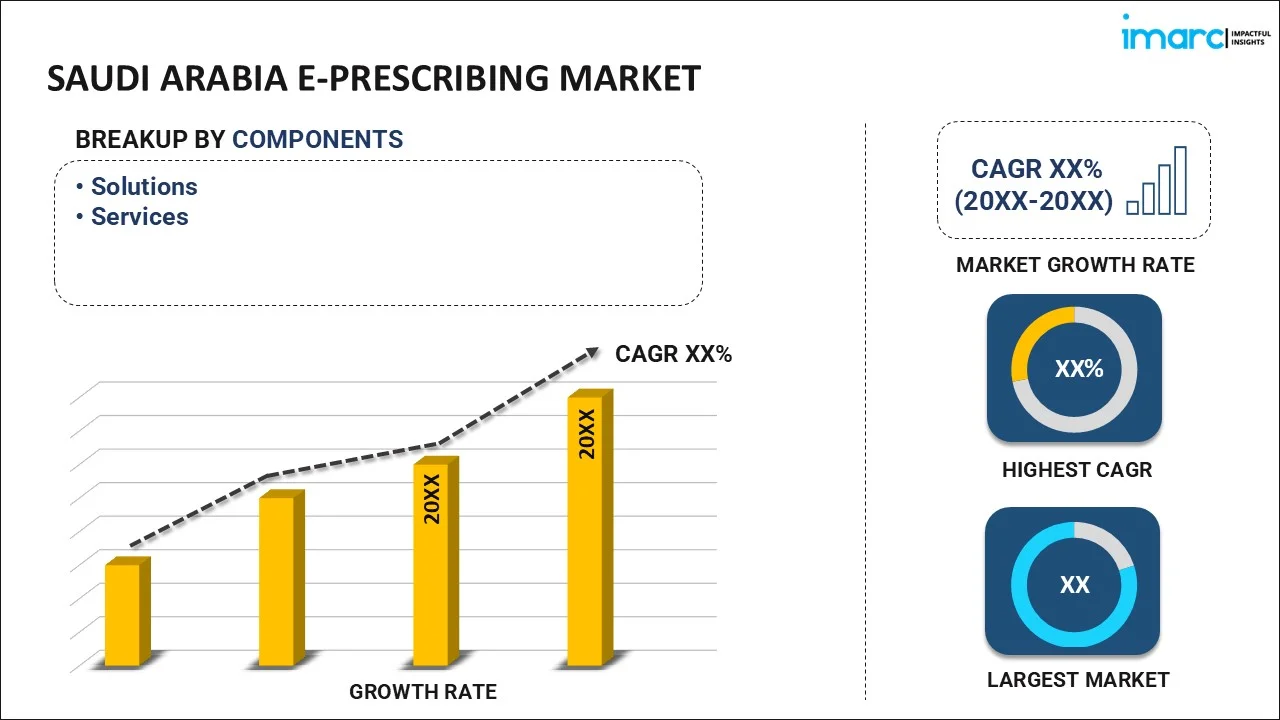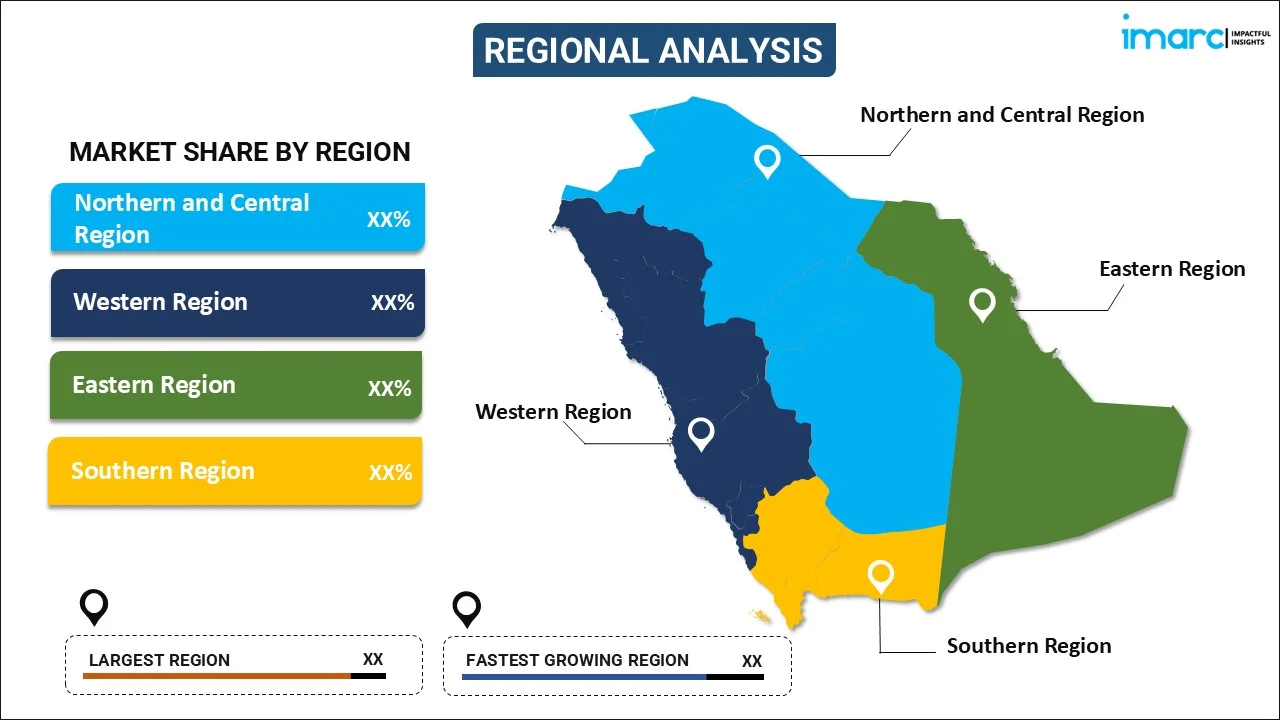
Saudi Arabia E-Prescribing Market Size, Share, Trends and Forecast by Component, Delivery Mode, End User, Specialties, and Region, 2026-2034
Saudi Arabia E-Prescribing Market Size and Share:
The Saudi Arabia e-prescribing market size reached USD 31.1 Million in 2025. Looking forward, IMARC Group expects the market to reach USD 191.7 Million by 2034, exhibiting a growth rate (CAGR) of 22.38% during 2026-2034. Government digital health initiatives, mandatory e-prescription regulations, increasing telemedicine adoption, AI-driven prescription management, rising chronic disease cases, enhanced patient safety, reduced medication errors, expanding healthcare IT infrastructure, cloud-based solutions, and growing investments in digital pharmacies are driving Saudi Arabia’s e-prescribing market growth.
|
Report Attribute
|
Key Statistics
|
|---|---|
|
Base Year
|
2025
|
|
Forecast Years
|
2026-2034
|
|
Historical Years
|
2020-2025
|
| Market Size in 2025 | USD 31.1 Million |
| Market Forecast in 2034 | USD 191.7 Million |
| Market Growth Rate (2026-2034) | 22.38% |
Saudi Arabia E-Prescribing Market Trends:
Government Initiatives and Regulatory Support
Saudi Arabia's government is taking big steps to back digital health solutions, like e-prescribing, to make healthcare better. A key project is the National Platform to Control Narcotic Drugs and Psychotropic Substances (Raqeeb). This platform aims to improve patient safety and simplify processes by managing prescriptions and giving out restricted substances. In 2018, the Health Ministry rolled out the Wasfaty e-prescribing system, which fits with the Vision 2030 plan. This system lets prescriptions move from health centers to pharmacies. Since it started about 68.2 million prescriptions have been filled at 4,000 pharmacies across the country. These projects show the government's commitment to bring digital tech into healthcare opening the door for more e-prescribing systems to be used. Additionally, the growing focus on interoperability and data security is fostering innovation in digital health infrastructure. Investments in artificial intelligence and blockchain technology are enhancing prescription accuracy and minimizing pharmaceutical errors. Consequently, Saudi Arabia is witnessing increased collaboration among public and private healthcare partners, accelerating the shift towards a fully digital healthcare ecosystem.
Integration of E-Prescribing with Telemedicine Services
The growth of telemedicine in Saudi Arabia has had a big impact on how people use e-prescribing systems. Many telemedicine platforms now include e-prescribing tools, which let doctors write prescriptions during online appointments. This makes things easier for patients and keeps the quality-of-care high. By 2025, experts think the digital health market in Saudi Arabia, which includes telemedicine and e-prescribing, will be worth $1.60 billion. This shows that more people are relying on digital solutions because of the e-prescribing options out there. Also, health worries from the pandemic have led more people to use telemedicine and e-prescribing services. Both patients and doctors are looking for safe and effective ways to give and get care. These services work well together and are easy to use, so they might keep being popular even after the pandemic ends. This could help the market grow. On top of that, government rules and support are making it easier for people to use digital health tools. Plans to make electronic health records (EHRs) more standard and connect them to e-prescribing systems are helping to get rid of problems and make the market bigger.
Saudi Arabia E-Prescribing Market Segmentation:
IMARC Group provides an analysis of the key trends in each segment of the market, along with forecasts at the region/country level for 2026-2034. Our report has categorized the market based on component, delivery mode, end user, and specialties.
Component Insights:

- Solutions
- Services
The report has provided a detailed breakup and analysis of the market based on the components. This includes solutions and services.
Delivery Mode Insights:
- Web-Based
- Cloud-Based
- On-Premises
A detailed breakup and analysis of the market based on the delivery mode have also been provided in the report. This includes web-based, cloud-based, and on-premises.
End User Insights:
- Hospitals
- Pharmacies
- Office-Based Physicians
- Others
The report has provided a detailed breakup and analysis of the market based on the end user. This includes hospitals, pharmacies, office-based physicians, and others.
Specialties Insights:
- Oncology
- Sports Medicine
- Neurology
- Cardiology
- Others
A detailed breakup and analysis of the market based on the specialties have also been provided in the report. This includes oncology, sports medicine, neurology, cardiology, and others.
Regional Insights:

- Northern and Central Region
- Western Region
- Eastern Region
- Southern Region
The report has also provided a comprehensive analysis of all the major regional markets, which include Northern and Central Region, Western Region, Eastern Region, and Southern Region.
Competitive Landscape:
The market research report has also provided a comprehensive analysis of the competitive landscape. Competitive analysis such as market structure, key player positioning, top winning strategies, competitive dashboard, and company evaluation quadrant has been covered in the report. Also, detailed profiles of all major companies have been provided.
Saudi Arabia E-Prescribing Market News:
- February 2023: Digital Diagnostics collaborated with Tamer Healthcare Co., a leading healthcare provider in Saudi Arabia, to enhance and expand digital healthcare offerings, including e-prescribing solutions, across the region.
Saudi Arabia E-Prescribing Market Report Coverage:
| Report Features | Details |
|---|---|
| Base Year of the Analysis | 2025 |
| Historical Period | 2020-2025 |
| Forecast Period | 2026-2034 |
| Units | Million USD |
| Scope of the Report |
Exploration of Historical Trends and Market Outlook, Industry Catalysts and Challenges, Segment-Wise Historical and Future Market Assessment:
|
| Components Covered | Solutions, Services |
| Delivery Modes Covered | Web-Based, Cloud-Based, On-Premises |
| End Users Covered | Hospitals, Pharmacies, Office-Based Physicians, Others |
| Specialties Covered | Oncology, Sports Medicine, Neurology, Cardiology, Others |
| Regions Covered | Northern and Central Region, Western Region, Eastern Region, Southern Region |
| Customization Scope | 10% Free Customization |
| Post-Sale Analyst Support | 10-12 Weeks |
| Delivery Format | PDF and Excel through Email (We can also provide the editable version of the report in PPT/Word format on special request) |
Key Questions Answered in This Report:
- How has the Saudi Arabia e-prescribing market performed so far and how will it perform in the coming years?
- What is the breakup of the Saudi Arabia e-prescribing market on the basis of component?
- What is the breakup of the Saudi Arabia e-prescribing market on the basis of delivery mode?
- What is the breakup of the Saudi Arabia e-prescribing market on the basis of end user?
- What is the breakup of the Saudi Arabia e-prescribing market on the basis of specialties?
- What are the various stages in the value chain of the Saudi Arabia e-prescribing market?
- What are the key driving factors and challenges in the Saudi Arabia e-prescribing market?
- What is the structure of the Saudi Arabia e-prescribing market and who are the key players?
- What is the degree of competition in the Saudi Arabia e-prescribing market?
Key Benefits for Stakeholders:
- IMARC’s industry report offers a comprehensive quantitative analysis of various market segments, historical and current market trends, market forecasts, and dynamics of the Saudi Arabia e-prescribing market from 2020-2034.
- The research report provides the latest information on the market drivers, challenges, and opportunities in the Saudi Arabia e-prescribing market.
- Porter's five forces analysis assist stakeholders in assessing the impact of new entrants, competitive rivalry, supplier power, buyer power, and the threat of substitution. It helps stakeholders to analyze the level of competition within the Saudi Arabia e-prescribing industry and its attractiveness.
- Competitive landscape allows stakeholders to understand their competitive environment and provides an insight into the current positions of key players in the market.
Need more help?
- Speak to our experienced analysts for insights on the current market scenarios.
- Include additional segments and countries to customize the report as per your requirement.
- Gain an unparalleled competitive advantage in your domain by understanding how to utilize the report and positively impacting your operations and revenue.
- For further assistance, please connect with our analysts.
 Request Customization
Request Customization
 Speak to an Analyst
Speak to an Analyst
 Request Brochure
Request Brochure
 Inquire Before Buying
Inquire Before Buying




.webp)




.webp)












